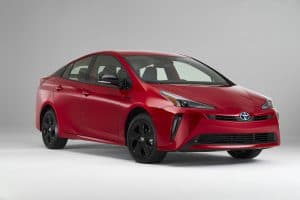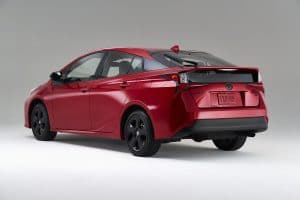The Model-T, the Beetle, the 911, the Willys CJ. There aren’t many cars that can claim to have “changed an industry,” but the original Toyota Prius certainly belongs on the list.
The world’s first mass-market hybrid-electric vehicle is just celebrating its 20th anniversary, and Toyota plans to offer a limited-production special edition to celebrate the occasion. Based on the top-line XLE front-wheel-drive model, the Prius 2020 will feature distinctive exterior trim and unique features, including a color-keyed rear spoiler.
The Prius platinum anniversary comes at a distinct time in history, the coronavirus pandemic locking down much of the globe’s automotive production while also sending fuel prices to lows not seen in a decade or more. Demand for high-mileage passenger vehicles, including hybrids like the Prius, was already tumbling, even before the crisis, and Toyota officials have told TheDetroitBureau.com that the automaker is giving serious thought as to where to go with the groundbreaking nameplate in the future.
(Q&A: Toyota’s hydrogen chief Jackie Birdsall.)
Toyota will produce just 2,020 of the anniversary edition models which will be offered in either Supersonic Red or Wind Chill Pearl with contrasting black exterior trim and that color-keyed spoiler. There will be black inserts for the 17-inch alloy wheels, and unique “2020” insignias inside, along with a black shift knob and interior trim.
Confusingly, the Prius “2020 Edition” will actually be a 2021 model, though there’s a plus to that as it brings with it an expanded list of advanced driver assistance technologies as part of the Toyota Safety Sense 2.0 system. That now includes automatic emergency braking for pedestrians and bicyclists, as well as other vehicles.
Though the “2020 Edition” will be based on a front-drive version of the Prius XLE, the hybrid is now offered with optional all-wheel-drive, one of the many updates it has received over the past two decades and four generations.
The latest model relies on a 1.8-liter Atkinson-cycle gas engine paired with two motor-generators linked through a continuously variable transmission, the package getting an EPA-estimated 54 mpg City, 50 Highway and 52 Combined. By comparison, the original Prius got 42 mpg City and 41 on the EPA Highway and Combined cycles.
Even so, those were unheard-of numbers when the original gas-electric hybrid model made its debut. The name, “Prius,” Toyota noted, comes from Latin for “first,” or “original,” and, it added in a statement, “can also mean ‘to go before.’
Toyota’s claim to going first does carry an asterisk, however. While the Prius was first in Japan, it actually landed in the critical American market a few months after Honda launched its own hybrid-electric vehicle, the Insight. But where that model never gained any significant traction, the Prius became an instant hit, sales buoyed by the line-up of celebrities – including Leonardo DiCaprio – who quickly parked one in their own driveways.
(Sales sliding, Toyota rethinks future of the Prius.)
Of course, it also helped that California regulators allowed the Prius to operate in the coveted High-Occupancy Vehicle lanes. The Golden State quickly became the largest market for the Toyota hybrid which, at its peak, was also California’s single best-selling nameplate.
But demand has been waning since the launch of the fourth-generation Toyota Prius in November 2016. Last year, sales of the various members of the “Prius family,” which included the C, V and Prime models, tumbled 20.4% compared to 2018, dipping to just 69,718 in the U.S. market. The original Prius liftback alone generated a record 181,200 sales in the U.S. alone in 2010.
Toyota has been searching for the right formula to rebuild momentum for Prius. It recently dropped the larger V model but has also expanded the range of the “family” with both the all-wheel-drive version added for 2019, as well as the plug-in hybrid Prius Prime.
Where the nameplate goes in the future is under serious exploration, several Toyota officials have confirmed. During the preview of the AWD models, Deputy Chief Engineer Koichi Kaneko said in an interview told TheDetroitBureau.com that, “For the next Prius we have to think about how to … separate [it] from the rest of the Toyota line-up.”

In addition to advanced technology and the benefits of a hybrid powertrain, the 2020 Edition is marked with special logos on the interior.
That’s becoming more difficult, however. Industry analysts point to a variety of factors that have cut into Prius sales. For one thing, fuel prices settled back even before the coronavirus pandemic, spurring a massive market shift from passenger cars to SUVs, pickups and other light trucks.
At the same time, Prius no longer offers a unique proposition. There are dozens of hybrids and plug-in hybrids available in the U.S. today, including an assortment from Toyota, including a plug-in version of its best-selling crossover, the RAV-4 Prime. And the Japanese automaker plans to unveil two “all-new” hybrids during a livestream on Monday, May 11.
(Toyota testing solar-powered Prius.)
What happens next with Prius is far from certain. The classic liftback model has undergone a number of changes since the original debuted two decades ago. And it seems likely that the fifth-generation hybrid will see still more. It may no longer be the volume-seller it was in its early days, with the hybrid market almost entirely to itself, but Prius remains a halo car for Toyota and the automaker isn’t going to let it fade away as have so many other once game-changing products over the years.




Oh my! It looks like they put lipstick on this pig with their left hand.